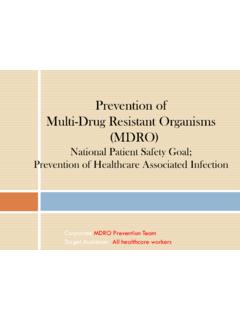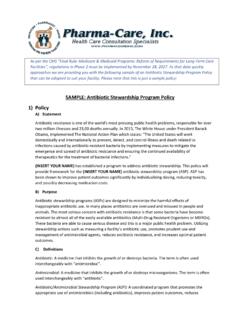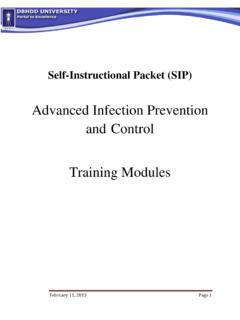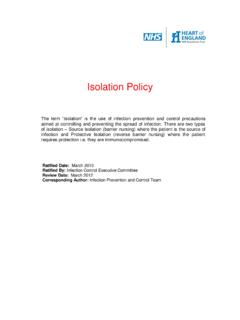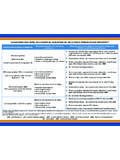Transcription of Prevention strategies for methicillin-resistant ...
1 S107 Prevention strategies for methicillin-resistant staphylococcus aureus (MrSA) in Latin AmericaaBstractAfter the first reports of the emergence of methicillin-resistant Staphylococcus aureus (MRSA) in the 1970s, numerous measures intended to prevent its transmission were initiated in hospitals. However, in most cases, large-scale measures failed to be implemented and the transmission of MRSA has since led to a global pandemic. Presently, doubts still remain about the best approach to prevent and control MRSA and more often than not, control measures are not implemented. Therefore, we review here the current situation in Latin America with respect to existing policies for control of MRSA, and evaluate the evidence for control measures in hospitals and the community.
2 We look at the risk factors for infection and transmission of MRSA between hospital patients and within specific populations in the community, and at the effect of antibiotic usage on the spread of MRSA in these settings. Finally, we summarize rec-ommendations for the Prevention and control of MRSA, which can be applied to the Latin American hospital environment and community setting. Keywords: MRSA, Prevention , infection control, Latin Staphylococcus aureus (MRSA) is the principal micro-organism responsible for caus-ing infections in the hospital and healthcare setting. Its prevalence has progressively increased over time and, although control measures intended to prevent its transmission were initiated in hospitals after its emergence in Europe,1,2 large-scale implementa-tion was belated, and as a result, the transmission of MRSA has led to a global addition, during more recent years, com-munity-associated MRSA (CA-MRSA) has also increased; an incidence of 59% of CA-MRSA in skin and soft tissue infections was reported by emergency departments in 11 US cities,3 making MRSA the most frequently isolated agent in this type of pathology.
3 These figures, together with the risk of development of glycopeptide- resistant S. aureus, make the need for worldwide imple-mentation of effective measures for the preven-tion of transmission of MRSA essential, both in hospitals and within the the exact burden of MRSA-related disease remains largely unknown, consensus ex-ists among most infectious disease (ID) physi-cians that MRSA infections are an important clinical and public health ,5 Within Latin America, although country to country vari-ability means that data on MRSA incidence from specific hospitals may not be representative of the national situation, it is accepted that overall, the prevalence of MRSA infections in the region is probably ,7 However, despite published epidemiologic and microbiologic data, the best approach to prevent and control the endemic MRSA has not been agreed upon.
4 Hospital control of endemic MRSA has been based on several complementary strategies : early identification and isolation of asymptomatic carriers to help prevent spread; antiseptic body washes; systemic and/or topical treatment, as well as improved compliance with hand hygiene and other standard precautions to reduce carriage; and antimicrobial control measures to reduce antibiotic selection pressure. This approach may help minimize the spread of MRSA, and reduce carriage and infection rates in hospitals where MRSA is endemic. Furthermore, compliance with these measures should have a positive clini-AuthorsCarlos Alvarez1 Jaime Labarca2 Mauro Salles3on behalf of the Latin American Working Group for Gram Positive Resistance.
5 1 Hospital San Ignacio and Pontificia Universidad Javeriana, Bogot , Universidad Cat lica de Chile, Santiago, Irmandade da Santa Casa de Miseric rdia de S o Paulo, S o Paulo, to:Dr. Carlos AlvarezDivisi n de Enfermedades InfecciosasDepartamento de Medicina InternaHospital San Ignacio, and Pontificia Universidad JaverianaBogot , ColombiaPhone: +57-1-3232667 or+57-1-594 6161(ext 4737)Fax: +57-1-3232667E-mail: of MRSA in Latin Americacal impact on key high-risk patients, such as those in the in-tensive care unit (ICU).Published guidelines have addressed the Prevention and control of MRSA transmission, including guidelines from the US Centers for Disease Control (CDC), and from the UK, Belgium, and This article summarizes the principal recommendations to control MRSA in the hospital and community settings, and discusses their implementa-tion in Latin anD control of Mrsa in the healthcare settingThe status of Prevention and control of MRSA in hospitals in Latin AmericaIn 1997, the International Network for the Study and Pre-vention of Emerging Antimicrobial Resistance (INSPEAR) performed an observational study in hospitals in 30 coun-tries, including six centres in Latin America (Argentina and Brazil)
6 , to help determine the prevalence and measures for control of transmission of MRSA at that Of the iso-lated cases of S. aureus, 67% were identified as MRSA, and there was an incidence of MRSA infection of per 1,000 patient-days of hospitalization. Only 4/6 centres (67%) had an active MRSA surveillance program, with a mean propor-tion of one infection control nurse for every 191 hospital beds (range from 1:80 to 1:324). These rates were higher than rates in the US, European and African centers. Isola-tion in an individual room was used only occasionally by 50% of Latin American centers and used regularly by 0% (compared with and , respectively, in Europe-an centers). Of Latin American centers, 33% regularly used gloves and aprons, 67% followed hand hygiene protocols and put up isolation posters on a routine basis, and 50% had implemented an antimicrobial control program (the control methods most frequently used were limited drug lists and evaluation by an ID specialist).
7 From this report, control of MRSA was evidently not optimal in Latin Amer-ica, and since rates of MRSA infection continue to rise in many areas, implementation of control measures still needs to be factors for MRSA infection in hospitals While it is clear from case-control studies that patients in-fected by MRSA and patients infected or colonized by other multi- resistant bacteria share common risk factors, such as personal circumstances, length of hospital stay and use of antimicrobial agents,16 the principal risk factor for MRSA infection is the transmission of MRSA between patients. This idea is supported by the fact that S. aureus, or any of its antibiotic- resistant forms, is a skin-carried agent that can be easily transmitted by contact, and by the fact that dissemina-tion in hospitals is clonal, very few clones are currently circulating throughout the world and, commonly, each hos-pital has only one or two clones circulating at the same of MRSAHand-contamination of healthcare personnel repre-sents one of the principal mechanisms for transmission of various bacterial agents from patient to patient, and has been recognized as such for more than a In numerous studies, MRSA and other multi- resistant micro-organisms, such as vancomycin- resistant ente-rococci (VRE)
8 , have been isolated both from the hands and gloves, aprons and other instruments used by health-care personnel involved in the care of patients infected or colonized by these ,19 Devine et reported isolation of MRSA from computer keyboards used only by doctors, while Boyce et al. (1997)21 found an incidence of 42% contamination of gloves used by nurses who had no direct contact with the patient, but who had touched surfaces in an MRSA-infected patient s of healthcare personnel s clothing has also frequently been reported in the literature as a factor in the transmission of pathogens from patient to patient. Boyce et al. (1998)22 reported an incidence of 40% and 69% contamination of isolation and white aprons, respectively, following the care of patients colonized with MRSA or VRE.
9 In 27% of cases, contamination was further transmitted to the hands of the healthcare personnel. In the Boyce et al. (1997) study21 MRSA was reported to contaminate aprons or uniforms worn by 65% of healthcare personnel who had cared for patients with wound or urinary infections caused by used in the daily care of patients, such as thermometers, sphygmomanometers, phonendoscopes and otoscopes have been reported23,24 to act as vectors for the transmission of pathogens such as MRSA and other multi- resistant bacteria between patients, both through direct patient-instrument contact, and indirectly through con-tact with the hands of healthcare personnel. In addition, new communication technologies can easily be contami-nated with MRSA and may have an impact on as the equipment used in managing patients can be contaminated with MRSA, patients rooms and the objects located in them can also act as reservoirs for the transmis-sion of resistant agents such as MRSA.
10 MRSA has been iso-lated from a wide range of objects, such as furniture, floors and cleaning Boyce et al. (1997)21 found that 73% of MRSA-infected and 69% of MRSA-colonized patients rooms had contaminated surfaces. It is important to stress that MRSA can remain on various surfaces for weeks and even months,27 thus increasing the risk of transmission. Di-etze et al,28 described cases where MRSA remained on the outer surfaces of sterile supplies for more than 38 , Labarca, SallesBraz J Infect Dis 2010; Vol 14 (Suppl 2):S107-S118 Use of antimicrobialsThe use of antimicrobials has been found to be a risk factor for MRSA infection, and the most consistent factor in case-control studies is the use of multiple antibiotics rather than one on its own (odds ratio [OR] ).










